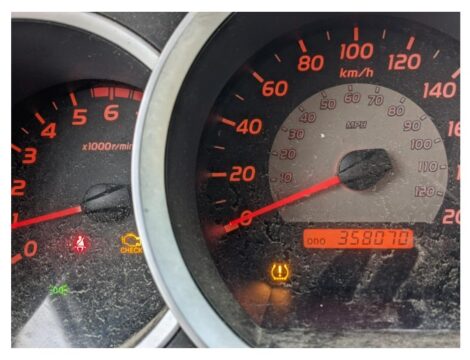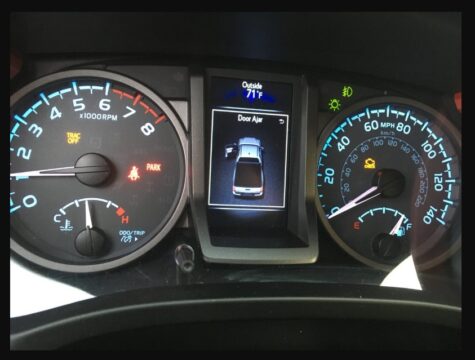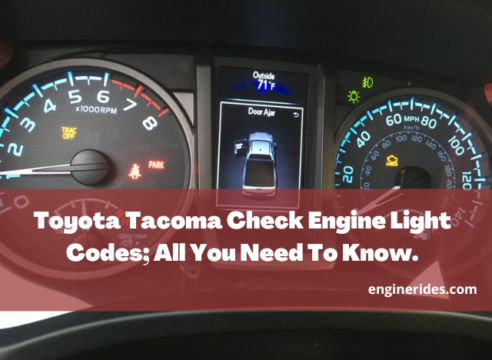Toyota Tacoma Check Engine Light Codes; All You Need To Know
Understanding the check engine light codes in your Toyota Tacoma is crucial for maintaining optimal vehicle performance and addressing potential issues promptly.
This article aims to provide comprehensive insights into decoding, retrieving, and interpreting check engine light codes specific to the Toyota Tacoma. By familiarizing yourself with these codes, you can troubleshoot and resolve problems effectively, saving time and money in the long run.
Table of Contents
What are Check Engine Light Codes?

The check engine light serves as an important warning system in your Toyota Tacoma. When it illuminates, it indicates that the vehicle’s onboard diagnostic system has detected an issue or malfunction.
It is a signal for you to investigate further and take appropriate action. Diagnostic Trouble Codes (DTCs) are specific codes stored by the system, providing information about the detected problem.
Check Engine Light and Its Purpose
The check engine light, often represented by the symbol of an engine, is located on the instrument cluster of your Tacoma dashboard.
It alerts you to potential issues in your vehicle’s engine components and emission control systems. Ignoring the check engine light can lead to more severe problems and even damage to your Tacoma.
What are Diagnostic Trouble Codes (DTCs)?
Diagnostic Trouble Codes are alphanumeric codes generated by the onboard diagnostic system. They provide specific information about the nature and location of the detected problem.
Each code corresponds to a particular issue or malfunction in a specific component, allowing you to pinpoint the source of the problem during troubleshooting.
Can WD-40 Be Used as Starter Fluid? By EngineRides
engine rides
Retrieving Check Engine Light Codes
To retrieve the check engine light codes from your Toyota Tacoma, you have a couple of options available to you. These methods will allow you to access the stored DTCs and gain insight into the underlying issues.
A- Using an OBD-II Scanner
An OBD-II (On-Board Diagnostic II) scanner is a handheld device connecting to your Tacoma’s OBD-II port. This port is usually located under the dashboard on the driver’s side. By plugging in the scanner and following the instructions provided with the device, you can retrieve the codes stored in the vehicle’s onboard computer.
Explanation of OBD-II Scanners
OBD-II scanners are essential tools for reading check engine light codes. They communicate with your Tacoma’s onboard computer to retrieve DTCs and provide you with valuable information about the detected problems. OBD-II scanners come in various types, ranging from basic code readers to advanced diagnostic tools that offer additional features and functionalities.
Steps for Retrieving Codes with an OBD-II Scanner
Using an OBD-II scanner is a straightforward process. Start by locating the OBD-II port in your Tacoma and connect the scanner. Turn on the ignition, but do not start the engine. Follow the instructions provided by the scanner to retrieve the codes. Once the codes are displayed, make a note of them for further interpretation and troubleshooting.
P0300 – Random/Multiple Cylinder Misfire: Indicates a random or multiple misfire detected in the engine cylinders. Potential causes include spark plug issues, fuel delivery problems, or vacuum leaks.
P0171 – System Too Lean (Bank 1): Indicates that the engine is running too lean on fuel in bank 1. Possible causes include a faulty oxygen sensor, vacuum leaks, or a clogged fuel injector.
P0420 – Catalyst System Efficiency Below Threshold (Bank 1): Suggests that the catalytic converter in bank 1 is not functioning optimally. Possible causes include a faulty catalytic converter, oxygen sensor issues, or exhaust leaks.
P0440 – Evaporative Emission Control System Malfunction: Indicates a problem with the vehicle’s evaporative emission control system, which helps prevent the release of fuel vapors into the atmosphere. Potential causes include a loose or faulty gas cap, a leak in the system, or a malfunctioning purge valve.
P0401 – Exhaust Gas Recirculation (EGR) Flow Insufficient: Suggests that there is an insufficient flow of exhaust gas recirculation. This may be due to a clogged EGR valve, a faulty EGR solenoid, or carbon buildup in the EGR system.
P0128 – Coolant Thermostat (Coolant Temperature Below Thermostat Regulating Temperature): Indicates that the engine coolant temperature is below the expected operating range. A faulty thermostat, a malfunctioning coolant temperature sensor, or low coolant levels may cause this.
P0442 – Evaporative Emission Control System Leak Detected (Small Leak): Indicates a small leak in the vehicle’s evaporative emission control system. Possible causes include a loose or damaged fuel cap, a leaking vapor hose, or a malfunctioning purge valve.
P0135 – O2 Sensor Heater Circuit Malfunction (Bank 1 Sensor 1): Indicates a problem with the oxygen sensor heater circuit in bank 1, sensor 1. A faulty oxygen sensor, a damaged wiring harness, or a blown fuse may cause this.
P0174 – System Too Lean (Bank 2): Similar to P0171, this code indicates that the engine is running too lean on fuel in bank 2. Possible causes include a faulty oxygen sensor, vacuum leaks, or a clogged fuel injector in bank 2.
P0500 – Vehicle Speed Sensor Malfunction: This indicates a problem with the vehicle speed sensor, which measures the vehicle’s speed. A faulty speed sensor, damaged wiring, or vehicle transmission issues may cause this.
These are just some of the most common check engine light codes that Toyota Tacoma owners may encounter. It’s important to note that each code represents a specific issue or malfunction within the vehicle’s systems. If you encounter a check engine light code, it is recommended to consult a professional mechanic or use an OBD-II scanner for a more precise diagnosis and appropriate repairs.
B- Using the “Flash” Method
For older Toyota Tacoma models, it is possible to retrieve check engine light codes using the “flash” method. This method relies on counting the times the check engine light flashes and correlating it to specific codes.
Description of the “Flash” Method
The “flash” method involves observing the pattern in which the check engine light illuminates and goes off.
You can translate the pattern into a corresponding DTC by counting the flashes and pauses.
Steps for Retrieving Codes Using the “Flash” Method
To retrieve codes using the “flash” method, turn the ignition key to the “On” position without starting the engine. Observe the check engine light and count the number of flashes, taking note of the length of pauses between each flash.
Consult the Toyota Tacoma service manual or online resources specific to your model to decipher the code based on the observed pattern.
Interpreting Check Engine Light Codes

Interpreting check engine light codes is essential for understanding the nature of the detected problems in your Toyota Tacoma. By decoding the DTCs, you can gain insights into the components or systems affected and take appropriate action.
A- Decoding the DTCs
Diagnostic Trouble Codes consist of alphanumeric characters that provide information about the type of problem and the location within the vehicle’s systems.
Common formats for DTCs include a letter followed by four numbers, such as P0300, or a combination of letters and numbers, such as B1S2. Each code has a specific meaning associated with it.
- Standard DTC Formats and Meanings
DTC formats may vary slightly depending on the year and model of your Toyota Tacoma. However, some standard formats and their meanings remain consistent across most vehicles.
For example, codes starting with “P” generally indicate powertrain issues, codes starting with “B” refer to body-related problems, and codes starting with “C” relate to chassis systems.
Understanding the Significance of Specific Codes
Each DTC carries specific information about the problem detected in your Tacoma. It is important to refer to resources such as service manuals, online databases, or professional expertise to understand the significance of specific codes.
This will help you determine the necessary steps for troubleshooting and resolving the issue effectively.
B- Identifying Potential Issues
Interpreting the check engine light codes allows you to identify potential issues within your Toyota Tacoma. Understanding the implications of specific codes allows you to gain insight into the systems or components requiring attention.
Overview of Common Problems Associated with Specific Codes
Different codes may point to specific problems that commonly occur in Toyota Tacoma.
For instance, a code indicating a misfire (e.g., P0300) may suggest ignition coils, spark plugs, or fuel delivery issues. Other codes may point to problems in the emission control system, such as oxygen sensor malfunctions or catalytic converter issues.
While check engine light codes provide valuable initial information, it is essential to note that they are not always definitive diagnoses. Some codes may have multiple potential causes, and further diagnostic procedures may be necessary to pinpoint the exact problem. A more precise diagnosis may require professional assistance or advanced diagnostic tools.
Exploring Interchangeable Seats for the Chevrolet Tahoe: A Guide by Generation
engine rides
Addressing Check Engine Light Codes
Once you have retrieved and interpreted the check engine light codes from your Toyota Tacoma, it is time to take action to address the underlying issues.
Depending on the severity and complexity of the problem, you can troubleshoot and resolve the problem yourself or seek professional help.
DIY Troubleshooting
For certain check engine light codes, basic troubleshooting steps can be undertaken by Tacoma owners themselves. This can help resolve simpler issues and potentially save on repair costs.
- Steps for Basic Troubleshooting Based on Specific Codes
For specific check engine light codes, there are general troubleshooting steps that you can take to address the problem. These steps may include inspecting and cleaning connectors, replacing faulty components, or resetting the system.
It is important to refer to reliable resources, such as service manuals or online forums, for guidance specific to your Tacoma model and the associated code.
- Common DIY Fixes for Certain Codes
Certain check engine light codes may have common DIY fixes that Tacoma owners can attempt. For example, a code related to an oxygen sensor malfunction might require replacing the sensor or cleaning the related wiring connections.
However, exercising caution and referring to appropriate resources is crucial to ensure proper procedures and safety.
Preventative Measures
Preventing check engine light issues in your Toyota Tacoma is essential for maintaining its performance and longevity. Regular vehicle maintenance and adopting preventative measures can help minimize the occurrence of check engine light codes.
Routine maintenance, such as regular oil changes, filter replacements, and scheduled inspections, is vital for keeping your Tacoma in optimal condition. Following the recommended maintenance schedule outlined in your vehicle’s manual can help identify potential problems early on and prevent them from triggering the check engine light.
Tips for Preventing Check Engine Light Issues
To minimize the likelihood of check engine light codes, consider the following tips:
- Use quality fuel and adhere to proper fueling practices.
- Maintain a clean air intake system by regularly inspecting and replacing air filters.
- Ensure the proper functioning of the vehicle’s emission control system by conducting periodic inspections and servicing.
- Promptly address any abnormal sounds, vibrations, or performance issues to prevent further damage.
- Regularly check and tighten the gas cap to prevent evaporative emissions-related codes.
These preventative measures can significantly reduce the chances of encountering check engine light issues in your Toyota Tacoma.
Conclusion
Understanding check engine light codes specific to your Toyota Tacoma is essential for effectively addressing potential issues and maintaining optimal vehicle performance. By retrieving, interpreting, and addressing these codes promptly, you can save time, money, and potential damage to your vehicle. Whether you troubleshoot and resolve the problem or seek professional assistance, staying proactive and attentive to your Tacoma’s check engine light will ensure a smoother and more enjoyable driving experience.
Remember, the check engine light is your vehicle’s way of communicating with you. Don’t ignore it. Embrace it as an opportunity to take care of your Toyota Tacoma and keep it running in top shape for years.







